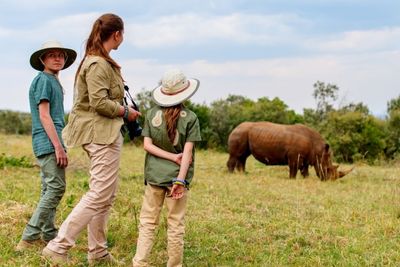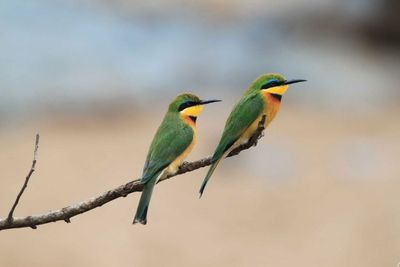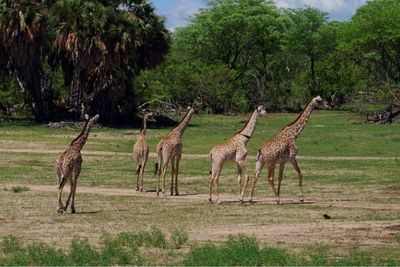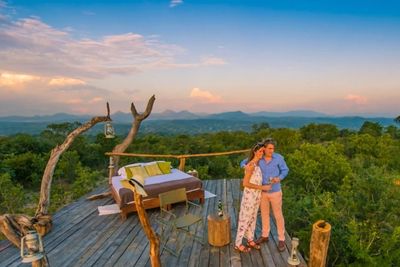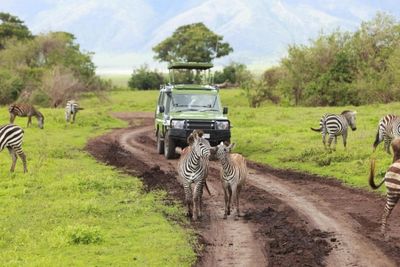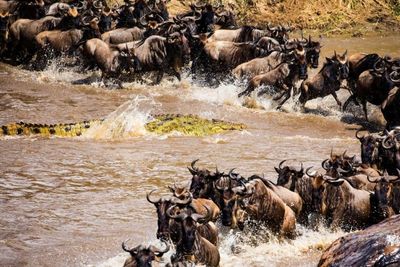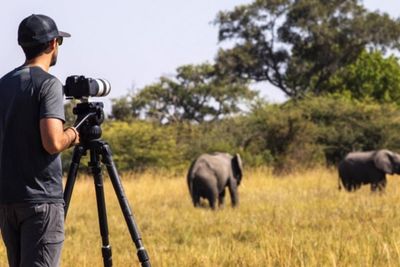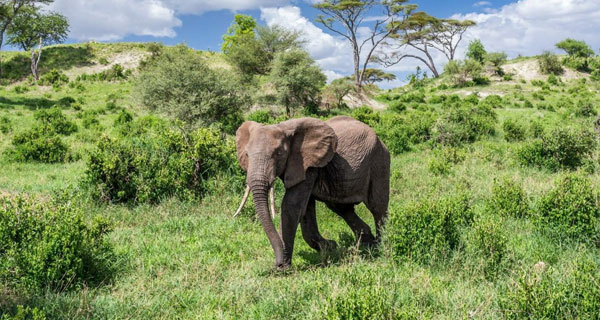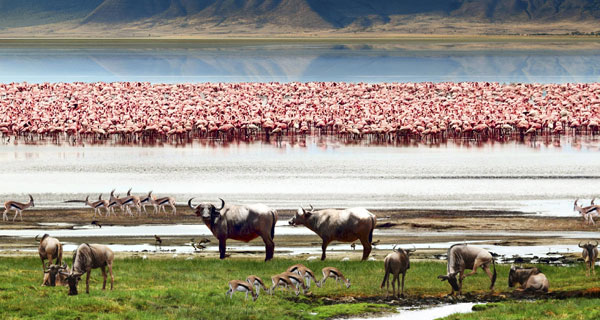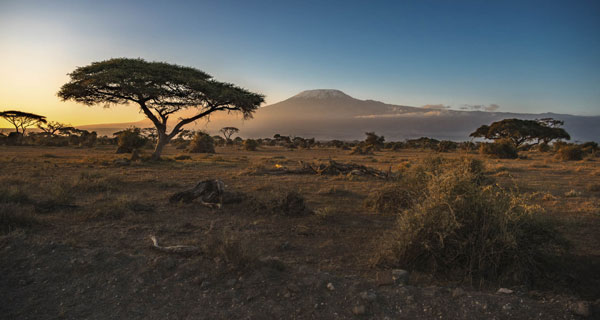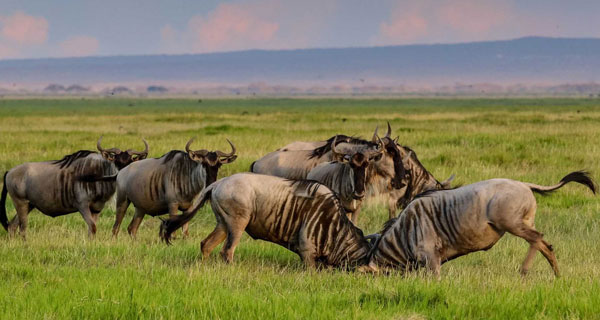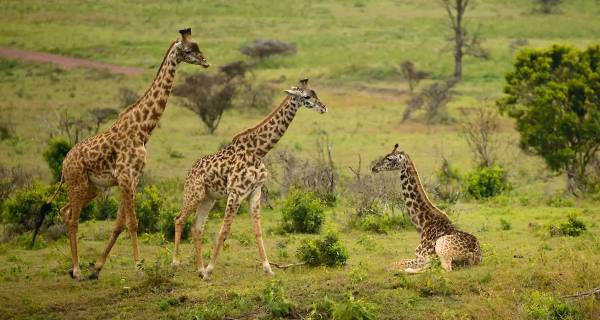The Ngorongoro Crater is one of the most unique places in Africa. It’s a UNESCO World Heritage site, home to diverse wildlife, including the Big Five. The stunning landscapes and rich Maasai culture make it a must-visit destination.
Let's Plan Tanzania
Ngorongoro Crater
Ngorongoro Crater, a UNESCO World Heritage Site in Tanzania, is the world’s largest intact volcanic caldera. Home to diverse wildlife including lions, elephants, and rhinos, it offers breathtaking landscapes and exceptional game viewing. This natural wonder is a must-visit destination for safari enthusiasts and nature lovers alike.
Discover Holidays to Ngorongoro Crater
Let’s take a moment to explore Ngorongoro Crater, one of the most remarkable places in Tanzania. This massive crater (260 km2) is located about 75 miles from Arusha and is part of a bigger Ngorongoro Conservation Area (8,292 km²). It was formed over 2.5 million years ago after a volcano collapsed, creating a vast caldera that stretches across 100 square miles.
The crater’s floor is a haven for a wide variety of wildlife, including elephants, lions, zebras, and the rare black rhinoceros, making it a prime destination for any Safari in Tanzania. Its grassy plains, forests, and the stunning Lake Magadi, known for its pink flamingos, add to the breathtaking scenery. You’ll also see the local Masai people, who have lived in harmony with this land for generations, grazing their cattle along the crater’s edge.
Ngorongoro Safaris offer more than just wildlife sightings – they give you a unique look into a landscape where nature and culture coexist beautifully. It’s a chance to witness the incredible diversity of Tanzania and truly feel the connection between the land, its animals, and its people.

Welcome to Tanzania! We’re excited to share our home with you. Every single day on a Safari in Tanzania is a delightful experience here. Travelling in the country provides sights that will awe and inspire you.
Juma Rajabu Sumbi
Managing Director
Why Visit Ngorongoro Crater?
Wildlife in Ngorongoro










The Ngorongoro Crater is a sanctuary for a wide range of animals, with nearly 30,000 large mammals living within its walls year-round. The crater’s enclosed environment helps keep animal numbers steady, making it one of the best places for wildlife viewing in Tanzania.
Elephants
Around 300 elephants, including large tuskers, are found in the crater, often seen wandering alone.
Lions
Ngorongoro has one of Africa’s densest lion populations, with over 60 lions, making it a prime spot to witness predator activity.
Black Rhinos
There are around 30 critically endangered black rhinos in the crater, making this one of the top places in Africa to see them.
Wildebeests, Zebras, and Buffaloes
You’ll encounter thousands of wildebeests, zebras, and buffaloes roaming the plains, with herds often gathering around watering holes.
Birdlife
With over 500 bird species, including flamingos and ostriches, the crater is a birdwatcher’s paradise.
Contrary to common belief, animals can enter and leave the crater, although the steep walls make it challenging. Herbivores occasionally migrate in search of food, while predators take advantage of the abundant prey. Some other interesting facts about Ngorongoro Wildlife are:
- – While the crater’s steep walls limit animal movement, some herbivores like wildebeests and zebras occasionally migrate out of the crater during the dry season to seek food and water.
- – Ngorongoro Crater is home to around 6,000 spotted hyenas, as well as jackals, golden wolves, and even elusive cheetahs. Leopards are harder to spot but still present.
- – The population of black rhinos in the crater has decreased from around 100 in the 1960s to about 30 today. They are closely monitored by conservationists with tracking devices.
- – The African wild dog and African golden cat are rare species found in the Ngorongoro Crater area, although sightings are extremely rare.
- – Birdwatching is excellent year-round, with notable species like Kori bustards, Fischer’s lovebirds, and flamingos. The Best Time to Visit Tanzania to see migratory birds is from November to April.
Numerous conservation efforts, such as anti-poaching campaigns and elephant corridors, are in place to preserve the wildlife here. A Safari in Tanzania to the Ngorongoro Crater will leave you in awe, providing an unforgettable wildlife experience.
When to go to Ngorongoro Crater
January
January is part of the rainy season in Ngorongoro Crater. The conservation area becomes lush, attracting large herds of elephants, zebras, and buffalo.
Predators like lions and leopards are often spotted early in the morning or late afternoon. Birdwatchers will enjoy seeing a variety of migratory species this month.
Despite the rain, January is one of the busiest times for safaris due to the vibrant landscape and active wildlife, making it a popular month for Tanzania Safari Holidays.
February
February is the warmest month, with daytime temperatures reaching up to 26°C (79°F). Wildlife is abundant in the crater, including elephants, lions, and the rare black rhino.
Hippos can be seen basking in the southeastern part of the crater. This month offers high chances of spotting large herbivores and predators within minutes of starting your safari.
Expect more tourists as February is a prime time for Tanzania Adventure Activities in Ngorongoro Crater.
March
March marks the transition to the long rainy season. While the crater becomes quieter with fewer tourists, the wildlife remains impressive, with buffalo, zebras, and elephants roaming the area.
Birdwatching opportunities remain excellent with many migratory species still present. The rains bring out lush greenery, making the landscape beautiful for photography.
March is ideal for a serene Safari in Tanzania, with special discounts available from many Tanzania Tour Operators.
April
April is the rainiest month in Ngorongoro, transforming the crater into a green haven.
Large herbivores such as elephants, antelopes, and buffalo are easy to spot grazing in the lush grass. While rains may limit visibility at times, you’ll still encounter wildlife frequently.
It’s also one of the least crowded months, offering solitude and lower prices on accommodation. April is a great time for those seeking a peaceful Tanzania Safari Adventure in Ngorongoro Crater.
May
May continues the rainy season but is considered the shoulder season for safaris. The abundant greenery attracts herbivores, including elephants, zebras, and antelopes.
Predators like lions are seen hunting near water sources. The rains also make birdwatching exceptional, with many species nesting.
Fewer tourists visit during this time, making May perfect for a quiet safari experience at a lower cost. For those seeking a less crowded Safari in Tanzania, May is an excellent choice.
June
June marks the beginning of the dry season, making wildlife viewing easier as animals gather near water sources.
Elephants, buffalo, and zebras are common sightings, along with predators like lions and hyenas. The cooler temperatures make early morning safaris pleasant.
June also offers fewer crowds compared to peak season, making it an ideal month for those looking to explore the Ngorongoro Conservation Area without the hustle of tourist groups.
July
July is the peak season in Ngorongoro due to the dry weather and perfect wildlife conditions.
Animals are drawn to the remaining water sources, offering fantastic game viewing. You can expect to see the Big Five, including lions, elephants, and rhinos.
The dry landscape makes it easier to spot smaller animals like warthogs and caracals. Be prepared for more visitors during this month, as July is popular for Tanzania Safari adventures.
August
August continues the dry season, with sunny days and minimal rain. Wildlife is concentrated around water sources, making it a prime time for game viewing.
Elephants, hippos, and zebras are easy to spot, along with lions and hyenas. The dry conditions also make it ideal for spotting smaller species like mongooses and serval cats.
Although it’s a busy month, August offers exceptional safari experiences, making it one of the best times for a Tanzania Safari Adventure.
September
In September, the dry season continues, and wildlife is concentrated around water sources like Lake Magadi.
Elephants, buffalo, and zebras are common sightings, along with predators like lions and leopards. The dry conditions make it easier to spot smaller animals like warthogs and caracals.
The lack of rain ensures clear views, making it a great month for photography. September is also less crowded than July and August, offering a more peaceful Safari in Tanzania.
October
October marks the transition from dry to rainy season. The weather remains pleasant, with fewer tourists in the crater compared to earlier months.
Wildlife such as elephants, buffalo, and zebras are still abundant, and you might also spot the rare black rhino. Predators like lions and hyenas are active during the early mornings and evenings.
October offers a perfect mix of great weather and fewer crowds, making it an excellent time for Tanzania Safari Activities.
November
November brings the short rainy season, rejuvenating the landscape. The rains spread wildlife across the crater, with elephants, lions, and buffalo roaming freely.
It’s also an excellent time for birdwatching as migratory species return. Fewer tourists visit in November, making it a peaceful time to explore the crater.
The lush scenery and active wildlife make it a great month for those looking to enjoy a quieter Safari in Tanzania experience.
December
December is a popular time for safaris, as the crater is bustling with wildlife.
Elephants, buffalo, and hippos are easy to spot, and lions and hyenas are frequently seen. The rains don’t disrupt the safari experience, and the green landscape offers beautiful scenery.
December is one of the busiest months, so it’s advisable to book your Tanzania Safari Holidays in advance to secure accommodations and safari bookings for an exciting adventure.
Things To Do In Ngorongoro
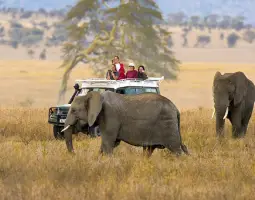
Game Drives Adventure
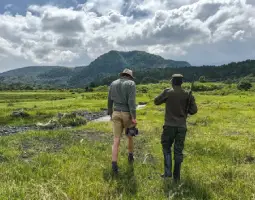
Crater Rim Walking Safari
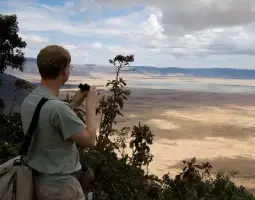
Photographic Safari Experience
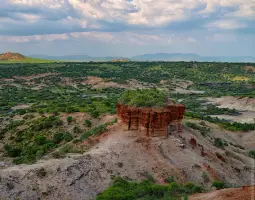
Olduvai Gorge Exploration
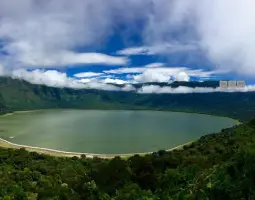
Empakai Crater Trek
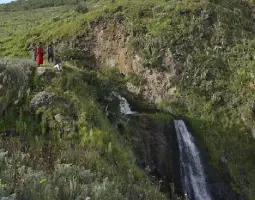
Olmoti Crater Hike
Personalize Ngorongoro Exploration
Arrange your dream visit to Ngorongoro Crater with custom itineraries that suit your pace and style. Experience unmatched wildlife and breathtaking landscapes your way.
Create your Ngorongoro adventure!
Safari Packages
Create Your Dream Journey
Personalize your itinerary or choose from our curated travel experiences.
Talk to a Travel Expert
Receive expert advice to plan your ideal adventure with confidence.
Explore Tanzania with Us
Best Safari Packages In One Place
Arusha, Tanzania
Duration: 10 Days
Experience: Birding Safari
Price: On request
Arusha, Tanzania
Duration: 7 Days
Experience: Honeymoon Safari
Price: On request
Arusha, Tanzania
Duration: 16 Days
Experience: Birding Safari
Price: On request
Arusha, Tanzania
Duration: 13 Days
Experience: Northern Circuits
Price: On request
Arusha, Tanzania
Duration: 8 Days
Experience: Wildbeest Migration
Price: On request
Arusha, Tanzania
Duration: 21 Days
Experience: Best of Tanzania
Price: On request
Arusha, Tanzania
Duration: 10 Days
Experience: Maximum Wilderness
Price: On request
Why travel With Sumbi Extra Miles Safari?
LOCAL KNOWLEDGE
Our guides share local culture and hidden treasures because they are intimately familiar with Tanzania. A wonderful and genuine safari experience is guaranteed when you travel with a crew that is well-versed in every aspect.
TAILORED TRIP PLANS
Every trip is designed to fit your interests and travel style. Our personalized arrangements guarantee that you get the most out of your vacation, whether your goal is adventure or leisure.
ECO CONSCIOUS APPROACH
To preserve Tanzania's natural beauty, we place a high priority on sustainable methods. By selecting us, you contribute to responsible tourism and conservation initiatives, protecting wildlife and natural areas for coming generations.
All You Need to Know for Ngorongoro Safari Travel
Getting to Ngorongoro Crater
Getting to Ngorongoro Crater is simple with travel options by road or air. The crater is about 185 km from Arusha, and the drive usually takes around four hours on paved roads.
By Road
Most visitors drive from Arusha, which takes about four hours. The drive from Serengeti is about three hours, and from Lake Manyara, it’s around two hours.
By Air
Daily flights operate from Arusha to the Lake Manyara Airstrip. From there, it’s a short 1.5-hour drive to Ngorongoro Crater.
We’ll handle transportation, ensuring a smooth journey to Ngorongoro Crater in Tanzania. Travelling to this natural wonder is easy and rewarding, setting you up for an amazing experience.
Ngorongoro Conservation Area Entrance Fees
The Ngorongoro Conservation Area is a UNESCO World Heritage Site with a range of fees for visitors depending on age and activities. These fees are typically paid at the park’s gates and vary for adults, children, and vehicles.
- Adults (16+ years): USD 50 per day
- Children (5-16 years): USD 10 per day
- Children under 5: Free
Additional fees apply for vehicle entry and camping, which can often be included in group tours.
If you’re driving into the park from Arusha, you’ll likely enter through the Loduare gate, while travellers from the Serengeti will pass through Naabi Hill gate.
The Ngorongoro Crater Safari is a major attraction within the park, offering incredible wildlife viewing and scenic beauty. Be sure to check all costs in advance and include them in your Tanzania Travel budget.
Weather & Climate
The Ngorongoro Crater enjoys a mild and temperate climate. It experiences a Wet season from November to May, with short and long rains, and a Dry season from June to October. Visitors should be prepared for cooler temperatures on the crater rim, especially in the mornings and evenings.
Dry Season (June to October)
The crater floor is sunny and pleasant with average temperatures around 19°C (66°F). Nights on the crater rim can be very cold, sometimes freezing.
Wet Season (November to May)
The Wet season has short rains from November to December, with temperatures around 23°C (73°F) on the crater floor. The long rains from March to May bring cooler weather, particularly on the crater rim.
Packing warm clothes is essential when visiting the Ngorongoro Crater, particularly for early morning safaris or stays on the crater rim. The Best Time to Visit Tanzania for Ngorongoro Safaris is often during the dry season, but the weather remains manageable all year, making it a great addition to any Tanzania Safari Itinerary.
Best Lunch Spots in Ngorongoro Crater
The Ngorongoro Crater may be smaller compared to other Tanzania National Parks, but its diversity in landscapes and wildlife makes it one of the most dramatic safari experiences. There are several distinct habitats to explore during your visit:
Crater Floor
This vast grassland is where most of the safari action happens. It’s home to thousands of grazing animals such as wildebeest, zebras, buffalo, and gazelles. Predators like lions and spotted hyenas roam here, hunting their prey. Visitors may even witness a thrilling big cat hunt.
Lake Magadi
Located in the centre of the crater, this soda lake is a haven for hippos and thousands of flamingos. The algae-filled shallows attract flamingos, while other bird species like pelicans and storks thrive here. It’s a top bird-watching spot in the Ngorongoro Crater Tanzania.
Crater Rim
Surrounding the crater is a steep, forested rim that creates a natural barrier between the caldera and the broader Ngorongoro Conservation Area. Leopards are known to inhabit this lush area, making it a prime spot for Tanzania Walking Safaris. These guided walks offer incredible views and opportunities to spot sunbirds, monkeys, and zebras.
Swamps
Gorigor and Mandusi Swamps, located in different parts of the crater, are rich in wildlife. Elephants, hippos, lions, and waterbucks are commonly seen in these wetlands. Black rhinos are also found here, making it a great spot for wildlife sightings.
Lerai Forest
This acacia and yellow fever tree forest on the crater floor is a prime area for spotting elephants, monkeys, and baboons. It’s also the best place to see the rare black rhinos that graze on the open plains during the day and retreat to the forest at night.
Ngorongoro Conservation Area
The Ngorongoro Crater lies within the larger Ngorongoro Conservation Area. Here, you’ll find vast plains where wildlife like zebras, wildebeests, and other large herds migrate. The Maasai people also live and graze their cattle here, providing a unique cultural experience as they continue their traditional way of life.
Exploring these areas offers a comprehensive Tanzania Safari Experience, combining scenic landscapes with the chance to see some of the most iconic wildlife.
Are Ngorongoro Crater Safaris Safe?
Yes, Ngorongoro Crater safaris are considered safe. You’ll be guided by experienced locals who know the area well. Sometimes, an armed ranger will accompany you to ensure extra protection when viewing wildlife.
- – Guides maintain a safe distance from animals, so you can enjoy sightings without worry.
- – While Ngorongoro was created by volcanic activity, the surrounding volcanoes are either dormant or extinct, posing no danger.
- – The roads can be rough, making guided tours much safer than self-driving, reducing stress and accidents.
General Tanzania Safari Safety Tips include avoiding walking at night and keeping valuables secure. Stick to bottled or filtered water to prevent any health issues. Overall, hygiene standards in lodges are high, so you’re unlikely to face any food-related problems during your Ngorongoro Crater safari.
Is Malaria Prevalent in the Ngorongoro Crater Area?
Yes, Ngorongoro Crater is a malaria area, so it’s important to take precautions. Mosquitoes and tsetse flies in the area can transmit malaria and African Sleeping Sickness. Here are some safety tips:
- – Wear long sleeves and trousers during dawn and dusk to reduce bites.
- – Use insect repellent regularly, especially in the evenings.
- – Sleep under mosquito nets for added protection.
- – Consult your doctor about anti-malarial medication before travelling.
By taking these steps, you can fully enjoy your Safari in Tanzania, with all the beauty and wildlife that the Ngorongoro Crater has to offer. Stay safe and explore with peace of mind!
Top Travel Tips for Ngorongoro
The Ngorongoro Crater gives a great safari experience. Here are some helpful tips to ensure a smooth and enjoyable visit to this world-famous destination.
Choose accommodation wisely
Stay on the crater rim for breathtaking views or opt for Karatu for a wider variety of lodges.
Avoid the crowds
Visit during the rainy season (April-May) to experience fewer visitors and enjoy peaceful game drives.
Family-friendly destination
With child-friendly lodges and abundant wildlife, it’s perfect for a family safari.
Prepare for chilly weather
It gets cold between June and August, so pack warm clothes.
With thoughtful planning and the right preparation, a Trip to The Ngorongoro Crater will be filled with stunning views and extraordinary wildlife encounters.








